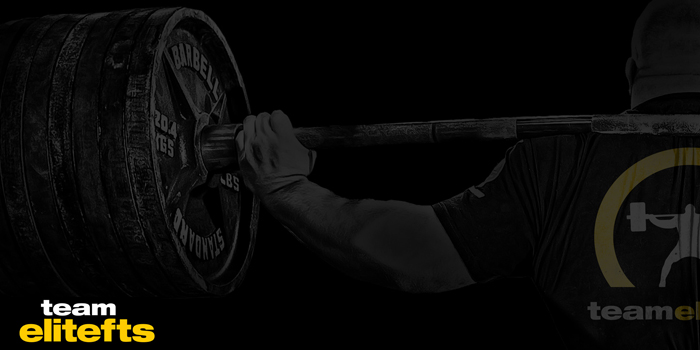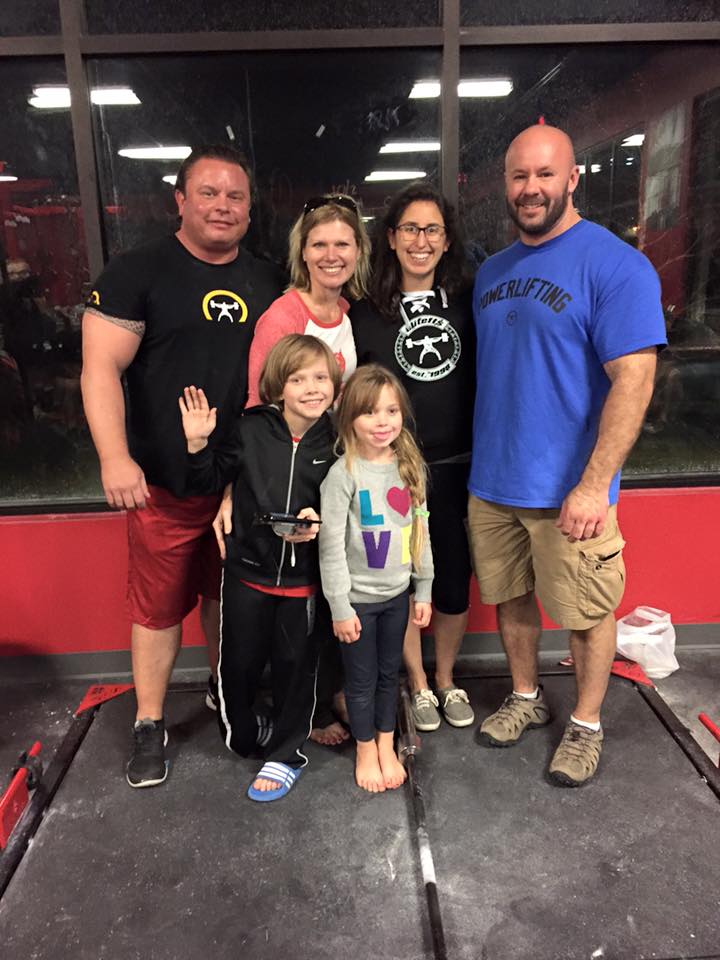
I used to be one of the Weekenders training at the elitefts Area S4. Those were glorious times, with PR after PR flowing freely. It was 2011 and I had just completed a multi-ply powerlifting meet with an 800 pound squat, 730 bench press and 600 deadlift for a 230-pound PR total of 2,130. Later that year, work and family considerations resulted in relocation from that Mecca of strength in the Midwest down to the burning pits of south Texas.
I went from training with a knowledgeable and dedicated crew to alone in my garage…from coaching cues by Dave Tate to reviewing videos on a tripod. It did not go well. I bombed twice in 2012. Everything was so screwed up by 2013, I passed out on my first two bench attempts before finally hitting a third to stay in a meet and total 100 pounds below my previous best.
The following year started off with a bang. Actually, it was more like a rip…of all the things that hold one’s shoulder in place. After a January 2014 surgery, I was back on the platform in December to hit another non-PR total of 2,050 pounds.
I was determined to make 2015 a year of progress. Training lifts felt stronger but were not transferring to a total when it counted on the platform. I had a plan to fix some of the flaws and to take a few extra trips back to S4 to identify others.
That plan hit a bump in the road when my cranium literally hit the road and a March motorcycle accident put me in intensive care with blood pooling on the brain. Just as training was re-commencing in June, I picked up a virus that sapped 30 pounds of bodyweight from my frame over a two-week period. I was small, weak and began to wonder if there would ever be light at the end of the tunnel.
WATCH: Passion Trumps Everything
Light did eventually shine. After plugging away for a couple months, I was at least strong enough to begin a meet training cycle in August. As bodyweight returned, weights on the bar moved faster and easier. Training started to click and the peaking process was even better. On meet day in December 2015, I hit an 816 squat, 711 bench press and 628 deadlift for a 25-pound PR total of 2,155.
Following more than four years of setbacks and learnings, progress finally materialized. Granted, it was only 25 pounds, but it felt great.
The Program
The meet training cycle was based on programming Dave Tate created for prior competitions, and then customized based on current weaknesses. It consisted of max effort on Saturday (upper) and Sunday (lower) and dynamic effort on Tuesday (upper) and Thursday (lower). Exercises were generally done in two to four week waves. Weight would increase and reps would decrease through each wave.
Main exercises were variants of the competition lifts early on and shifted to replicating the main lifts as the meet got closer. Accessory work was a larger percent of overall work early on, focused on weaknesses, and became less significant as the meet approached. Targeted weaknesses were abs and low back to remain upright and hold an arch while squatting, triceps for bench lockout, and better engagement of glutes during lockout of the deadlift.
While I did not program deloads for the sake of deloading, there were two weekends that acted in a similar fashion. The first was a free weekend halfway through the cycle with no prescribed exercises or weights — I lifted heavy, just with whatever I felt like doing on those two days. This allowed me to avoid aches and pains and focus on areas that were feeling good and ready for the added work.
The second was taking an entire week off when I was three weeks out from the meet. Our family had a week-long vacation with no access to a gym, so I just took it easy. This unload week was out of necessity more than anything, but it ended up being productive. Upon return to the garage for the last two weeks of training, I felt incredibly rested and strong. Family vacation or not, I plan to step away from training three weeks out from my next meet as well.
The Meet
The meet was sanctioned by the SPF and hosted by Austin Simply Fit, just north of Austin, Texas. This was a three-hour drive from my home, so the family and I made a long weekend out of it. I wasn’t planning to cut weight, but was only five pounds over the SPF’s 259 weight class cutoff, so restricted sodium and carbs for a couple days and weighed 259 on the nose.
Meet director Mark Rogers was on the ball and posted the flights a few days ahead of time. I was admittedly concerned with the 86 lifters resulting in four flights of 20+ lifters each. Few things are more draining than deadlifting 12-14 hours after your first squat. However, the timer was being enforced, breaks were minimal, and the spotters and loaders were on point. The event moved quickly and the time between lifts was as expected in an efficiently run meet. Kudos to Mark and his team for that.
Former S4 training partner Ted Toalston flew from Ohio to Texas to act as handler and to explore Austin. Ted is rock-solid from a technical standpoint and is able to immediately identify flaws and to keep my head where it needs to be during competition. Lily Starobin made the trip as well. In addition to them both being of great assistance during the meet, we all had a great weekend. I can’t thank them enough.
WATCH: Ted Toalston's Four Steps of Meet Handling
Squat: Metal Ace Pro briefs and Ace Pro squat suit. Opened with 722 for three whites. Went to 783 for the second attempt. Good lift. Took 816 for a 16-pound PR on the third. Down and up for three more whites and a good lift. Squats had never felt better.
Bench: Metal Viking Pro bench shirt. Opened with 678, good lift. Moved to 711 for the second attempt, struggled to touch, but pressed it nicely for another good lift. Here came the only adversity of the day. A month out I had strained a pectoral muscle. It hadn’t fully healed and was burning after the second attempt. I was mildly concerned, but decided to go for a five-pound PR of 755 on the final bench. The press felt fine after the touch, but I could not push through the transition point where the triceps take over. I called for the spotters to take it. No lift.
Deadlift: Metal Ace Pro squat suit. The deadlift has always been my weakest link. Getting the bar off the floor is fine, but I stall at lockout. I switched to sumo style for this meet and focused training on pushing the hips through. My deadlift numbers are still terrible, but finally showing signs of improvement. Opened with 573 for a good lift. Went to 606 on the second attempt in order to secure a whopping three pound full-meet PR and got it. Went to 628 on my final lift of the day and locked it out fairly easily. This was an 18-pound deadlift PR and bumped my meet total PR to 25 pounds at 2,155.
Conclusions
There were various technical learnings from this meet:
- The Safety Squat Yoke Bar was used prodigiously in early weeks of the training cycle and had a positive impact on ability to hold an arch.
- Heavy pulldown abs using a wide squat stance helped stabilize upper body and remain more upright.
- Triceps work had lockout feeling strong, but I neglected to do enough upper back work to stabilize the bar properly during the bench press.
- Competition lifts over the last six training weeks were done more in full gear than in the past, which was desperately needed to iron out technical issues and build confidence with heavier weights.
- The family-vacation-forced unload three weeks out allowed my body to refresh and prepare for the final push to the meet.
From a high-level perspective, my one big takeaway is that consistency is key. The last four years brought a 1,200-mile family relocation, adjusting to training in multiply gear alone, surgery, a job change, a motorcycle crash, a virus, and the general day-to-day demands that come in a household with both spouses working full-time while juggling school, baseball, football, gymnastics and all else that raising two young kids entails. Not to mention that at 43 years of age, I am no spring chicken anymore.
Through this adversity and activity, I maintained consistency around training. Sometimes that meant training at 5 a.m.; sometimes that meant 9 p.m. This consistency has been maintained not because I am hardcore, willing to do whatever it takes, go big or go home, or whatever other slogan of the day might be circulating. I simply enjoy the process of lifting, being strong, and continuing to get stronger, as measured by a powerlifting total.
In fact, I pity the fool who does something as taxing and unprofitable as powerlifting as a forced obligation and not an enjoyable hobby/lifestyle. Time and resources are finite in life. To put significant leisure time and effort into any endeavor that is not enjoyable does not compute.
There is a saying here at elitefts that Passion Trumps Everything. I have no designs on being a world champion and I don’t care about breaking federation records. I care about maximizing strength potential within the confines of my life’s infrastructure and established priorities, of which powerlifting ranks behind family and career. Passion is the catalyst and binder enabling the required consistency to make this process possible. Without passion, the process disintegrates.
This is why saying Passion Trumps Everything makes sense to me. Passion is not all that is needed to achieve what is sought. However, without passion, the journey never happens.











2 Comments